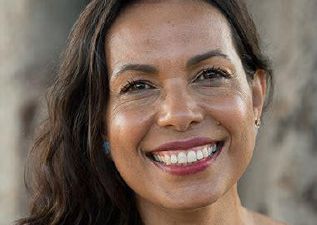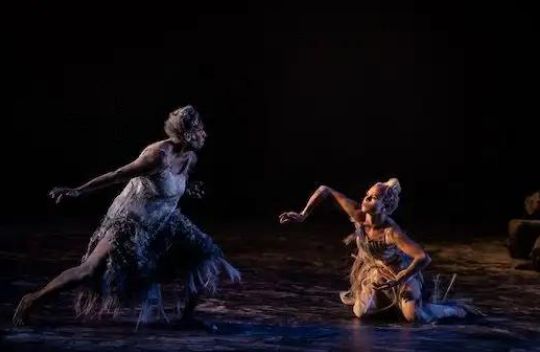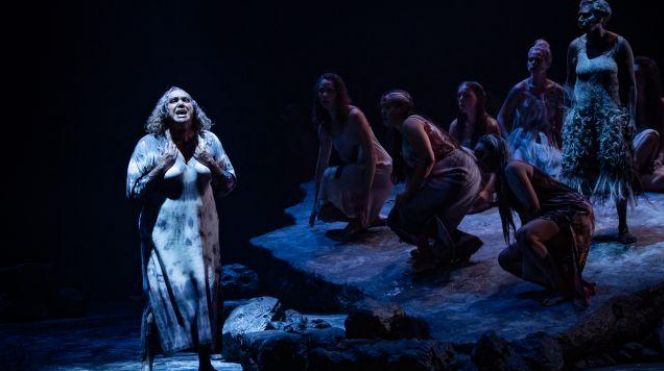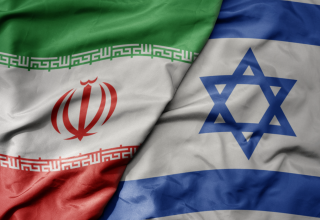Bangarra Dance Theatre and Wudjang: Not the Past
by Wallace McKitrick *
In January 2022, Sydney Festival hosted the premiere of Bangarra Dance Theatre’s Wudjang: Not the Past, an ambitious and politically important work which has stimulated much acclaim and discussion. In March the production played to full houses during the Adelaide Festival of Arts, receiving standing ovations.
This article briefly sketches the evolution of Bangarra Dance Theatre, the contribution of artistic director Stephen Page, and thoughts on the significance of Wudjang and Bangarra in the context of continuing colonialism in Australia.
THE COMPANY
‘Bangarra’ is a Wiradjuri word meaning ‘to make fire’. The company’s stated mission is, ‘To create inspiring Aboriginal and Torres Strait Islander experiences that promote awareness and understanding of our cultures.’ As a group of professional Aboriginal and Torres Strait Islander performers, ‘we are storytellers. We are fire makers. We create powerful works of theatre with dance, music, poetry and design. We tell the stories of our Elders, create works on Country and return the works we create to the place they were made.’ [i]
Born in 1989 from the creative vigour of the National Aboriginal and Islander Skills Development Association (NAISDA), Bangarra Dance Theatre has consistently been an extraordinary aesthetic and cultural force. Not confined to classy metropolitan venues, the company annually tours a world premiere work across Australia, ‘at home performing on Country, in tiny venues in regional centres and on Australia’s most iconic stages’ as well as running education workshops, programs and special projects ‘to nurture the next generation of storytellers.’ They also mount international tours.
Audience is an important question for the company. ‘We are for the hundreds of First Nations Communities across Australia– and for anyone who wants to be a part of our story. … Our community programs aim to generate creativity and share Aboriginal and Torres Strait Islander arts and cultures with the wider community.’ [ii] This generosity of spirit is an important part of the chemistry which has produced dynamic, spell-binding artistic work often defying conventional western genre categories. Wudjang: Not the Past is no exception, with reviewers suggesting this production is Bangarra’s most ambitious yet.
Before we look more closely at Wudjang, let’s pay tribute to Stephen Page, artistic director since 1991, who will hand over this role to Frances Rings in 2023.
STEPHEN PAGE – ARTISTIC DIRECTOR

Born in Brisbane, Page is a descendant of the Nunukul people and the Munaldjali clan of the Yugambeh Nation from South East Queensland. His brothers, composer-musician David and dancer Russell (who have both now passed away), were also founding members of Bangarra. ‘We are from a big family and a clan,’ says Stephen Page, ‘and we move as a mob – that philosophy is lingering through the company’.[iii]
Appointed artistic director of Bangarra in 1991, Page’s choreography and direction quickly caught the attention of dance and theatre critics. His keen collaboration with other choreographers, musicians and performing artists further enriched the company’s work.
The wellspring of Bangarra’s power, though, has been collaboration with Aboriginal language groups in numerous regions. Describing the life-cycle of a new work over three to four years, Page says, ‘we are generously entrusted by the Community with their Language, stories, songs and dances, which we then honour on stage. At the end of a work’s life-cycle, once it has been realised and performed to audiences all over Australia, we return the work to be performed on Country, in thanks and acknowledgement of the reciprocal relationship between the story and Country.’ [iv]
Recognition of Page’s outstanding artistic ability resulted in his being invited to direct the Indigenous sections for the 2000 Sydney Olympic Games opening and closing ceremonies, and to create a new dance work for the 2018 Commonwealth Games opening ceremony. His choreography is central in the feature films Bran Nue Dae (2009) and The Sapphires (2011)
Several of the almost 30 works Page has choreographed for Bangarra have won Helpmann Awards, including Skin (2001), Mathinna (2009), Fire – a Retrospective (2010), and Bennelong (2018). Other awards include the 2016 NAIDOC Lifetime Achievement Award, the JC Williamson Award (also in 2016) and a 2017 Australia Council Dance Award for ‘significant contributions to the cultural and artistic fabric of the nation’.
FRANCES RINGS – INCOMING ARTISTIC DIRECTOR

Frances Rings, who will become artistic director in 2023, is a Bangarra veteran. A descendant of the Kokatha people of West Coast South Australia, Rings was appointed associate artistic director in 2019. Her choreography in Rations (2002), Unaipon (2004), Sheoak (2015) and SandSong (2021), among others, has received high praise. She has choreographed works for leading Australian dance companies such as West Australian Ballet and Tasdance, as well as dancing in works by leading choreographers and companies including Meryl Tankard, Leigh Warren and Legs on the Wall. She was Head of Creative Studies at NAISDA Dance College 2016-2019. Awards to Rings include a Deadly Award, an Australia Council Australian Dance Award, and six Helpmann Awards.
WUDJANG: NOT THE PAST
Wudjang: Not the Past, co-written by Page and playwright Alana Valentine, is a collaboration between Bangarra Dance Theatre and Sydney Theatre Company under Page’s overall direction. Bringing together 17 dancers, four musicians and five actor-singers, it is Bangarra’s largest stage production to date. The work combines elements of opera, drama, story-telling, musical theatre and contemporary dance.
In an interview with ABC News, Stephen Page estimated that during his 32 years as artistic director as many as 120 different clan groups and families from across the country have entrusted him with their stories.[v] Conceiving of the current work, he drew on his own Yugambeh ancestry.
Bangarra’s study companion to Wudjang explains:
‘The Yugambeh Language region includes traditional lands that lie within and between the Danggan Balun (Five Rivers), Christmas Creek (Migunberri Tribe), Beaudesert (Mununjali Tribe), Logan (Guginin Tribe), Coomera (Bullongin Tribe), Mt Tambourine (Wanagerriburra Tribe), Nerang (Kombumerri Tribe), Birinburra Tribe and Tweed River Valley (Minjungbal Tribe).
From the early 1800s, the people of the Yugambeh Language region encountered many non-Indigenous people coming to their Country – shipwrecked sailors, escaped convicts, explorers, missionaries, government officials, military troops, settlers, and pastoralists. While some of these visitors were merely trying to survive in challenging circumstances, it was when the pastoralists, backed by the colonial government, started to significantly take up control of large tracts of land that the region became one of many places in Australia where the so-called frontier wars occurred.
These were violent times and the impact on Indigenous people was devastating. Many Indigenous people in the area were being forced on to reserves, being essentially written out of any economic benefits to agricultural development and were treated (and often impounded) by a legal system that was completely different to their own.’ [vi]
Page’s parents, he says, were from a generation who were deeply affected by assimilation policies which penalised Aboriginal people who attempted to maintain cultural transmission, and ‘these experiences meant they didn’t often talk openly about their cultural knowledge and language.’ [vii] His sister Donna Page, Yugambeh language consultant for the Wudjang production writes:
‘When Dad was a young boy, he never spoke language due to Assimilation. If young people spoke in language at school they’d get into trouble. Mum never spoke her language. She did not know about her Aboriginality. Her brothers told her they were Maori, as it was more acceptable to be another Indigenous culture than to be Aboriginal. Mum and Dad survived the racism of assimilation. When they married, they had to work hard to keep their family together during those challenging and hard times. When I was a young girl, I thought everybody was Aboriginal until I went to town with Mum in Beaudesert. During my schooling we were teased. I remember a teacher making me stand facing the back wall. I was in school, but I was never taught anything. Mum and Dad couldn’t do much about it. It’s the way things were then.’
Donna Page’s testimony above begins to prepare us for the emotional content of Wudjang in a different way from the more matter-of-fact official synopsis:
‘In the deep darkness just before dawn, workmen find bones while excavating for a dam. Among them is a Yugambeh man, Bilin, who convinces his colleagues to let him keep the ancestral bones. This ancestor is Wudjang, who longs to be reburied the proper way. With her young companion spirit, Gurai, she dances and teaches and sings of the past, of the earth, of songlines. With grace and authentic power, a new generation is taught how to listen, learn and carry their ancestral energy into the future. Wudjang: Not the Past follows the journey to honour Wudjang with a traditional resting place on Country.’ [viii]
Stephen Page’s director’s statement gives further insight into the depth of this work’s concerns:
‘ “Wudjang” is our Yugambeh word for mother, but in this work we use the word as a metaphor for the way both urban and traditional clans can use knowledge of the past to build a strong future, to carry and own trauma, and build a shield of resilience for future generations. Wudjang is our mother as the land is our mother; our sustenance, our wonder, our future. Our stories and our culture are not from the past or in the past – they are, as you will vividly see on stage – alive and in the present. Nor is the trauma or pain we have suffered in the past; that too is carried all too freshly, and manifested all too tragically in the present. The way forward, the way that Wudjang teaches, is to own and speak our difficult truths together, to draw strength from our solidarity with those who respect culture, and to reconnect with patience.’ [ix]
Many reviewers’ columns are available, discussing specific aspects of the design, technical prowess and emotional strength of Wudjang: Not the Past. Of course, some reviewers have relatively minor negative criticisms, but overall the production is hailed as an extraordinary artistic accomplishment. Links to a number of reviews are provided in the end-notes to this article. [x]
For this writer, being present at a performance during the Adelaide Festival was a profound experience: harrowing and uplifting. Emotionally churning scenes and songs tell the story of invasion, sexual predation, forced labour, courageous resistance. Throughout, dancers Elma Kris as ancestor Wudjang and Lilian Banks as spirit of renewal Gurai maintain a mesmerising dyad, conveying to us that history is not linear and liberation can be plucked from deepest oppression. The work represents both a cry of pain from every part of this continent, and an assertion of life-giving qualities which overcome horror and bring repair and resurgence. The pain is the pain of all of people who are subjected to harsh exploitation, invasion or genocide; and the assertion of survival, cooperation, cultural and spiritual integrity, and sheer aesthetic beauty, is for all humanity. In that sense Wudjang: Not the Past is a beacon to young people throughout the world as they face economic and social tumult occasioned by the intransigence of profiteers even as our planet’s climate emergency accelerates.
WUDJANG AS THE FUTURE: THE SIGNIFICANCE OF BANGARRA IN THE CONTEXT OF CONTINUING COLONIALISM IN AUSTRALIA

Dispossession and massacre by white settlers hungry for land are depicted frankly in Wudjang. Sexual brutality, and women’s resolve and resistance, are powerfully portrayed. The work exemplifies the truth-telling journey now gathering pace in Australia. The objective is clearly to tell the story of this country and to deconstruct falsehoods at the root of ‘nation’, as indispensable steps toward achieving reparation and a shared, just society.
Revitalisation of Aboriginal languages which have been actively suppressed by colonial authorities is central in the conception of Wudjang. ‘Language is a lifeline. Language is the carrier of knowledge, the means for listening, communicating, and learning across generations. Language is a medicine.’ [xi] Not only is each language born of the land, it is crucial – along with poetry, song, chant and dance – for keeping the fire, the philosophy of human connection with all elements of our biosphere.
In its vision, its extraordinarily rich artistry, and its moral and political implications, Wudjang is entirely consistent with the Uluru Statement from the Heart promulgated in 2017, part of which says:
‘We seek constitutional reforms to empower our people and take a rightful place in our own country. When we have power over our own destiny our children will flourish. They will walk in two worlds and their culture will be a gift to their country.’
More generally, given that foreign control continues to distort and impoverish working people’s lives here, both Wudjang and the Statement’s call for Makarrata/Treaty are important in the movement for a genuinely sovereign Australia forged through peace-making internally and externally.
BANGARRA AS A VITAL FORCE IN COMMUNITY ARTS
Reviewer Chantal Nguyen remarks perceptively:
‘… three remarkable decades saw Bangarra trail-blaze through Australian history and dance, reshaping national discussions on Indigenous identity. Australia would not be the same without Bangarra – a triumphant story of vision, voice and talent against the odds. … Other critics have remarked Wudjang defies categorisation or is multi-form, but I think what is actually happening is that Wudjang, with its Indigenous core, explores the creation of a new genre.’ [xii]

Nguyen’s remarks point to Bangarra as an exemplar of art rooted in community life and expressing people’s deepest sentiments and aspirations. We’re in an era when the most affluent and prevalent arts are those of advertising, and the majority of films found on television or in our cinemas either present unreal existences or give material shape to ideological myths. Australian artists in all mediums are hard-pushed to make a living, and this is doubly so if they are committed to working with communities and/or as individual artists making meaning from real lives, predicaments and aspirations. (This does not imply literalism or any prescription about artistic modes.)
Australia has a fine legacy of community-based art processes and products since the 1890s, often nurtured by trade unions, the socialist New Theatre movement, country communities, and in more recent decades by artists’ associations and some local governments, but it is a legacy kept fairly invisible by anti-democratic custodians of ‘news’ and ‘nation’. We also have a fine history of arts organisations devoted to top-quality performance and reinterpretation of renowned composers, playwrights, choreographers and other creators.
Bangarra Dance Theatre has managed during its 32 years to conjoin these paths which are often separate in our society’s arts practice. Eschewing the top-down ‘service delivery’ concept inherent in government and big business support of ‘flagship’ arts companies, Bangarra treats this country’s collective artistic life as a mosaic of mutually reinforcing ingredients. As mentioned early in this article, they ‘tell the stories of our Elders, create works on Country and return the works we create to the place they were made’ as well as running workshops and special projects to nurture the next generation of storytellers. They unite the best of community cultural development principles with powerful artform innovation and internationally recognised performance skills.

It seems fitting to end this article with the words of the final song of regeneration in Wudjang:
‘While the wind is fierce we are
While the trees clutch sky we are
While the moon shines soft we are
While the mountains wait we are
While the land is here we are
While the land still breathes we are
While the rivers run we are
We will never leave’
———————————————–
* Wallace McKitrick worked in community based cultural projects for 25 years, then in Aboriginal and Torres Strait Islander Commission programs and other federal measures to support Indigenous communities’ initiatives to maintain their distinctive languages and cultures.
[i] Website of Bangarra Dance Theatre https://www.bangarra.com.au/ Accessed 27/3/22
[ii] ibid.
[iii] https://www.portrait.gov.au/content/also-creative-kin Accessed 27/3/22
[iv] https://www.bangarra.com.au/about/creative-life-cycle/ Accessed 27/3/22
[v] Bangarra Dance Theatre’s Wudjang: Not The Past returns to Stephen Page’s country for epic work of language reclamation – ABC News Accessed 27/3/22
[vi] https://www.bangarra.com.au/media/oymprpqr/final_wudjang-studyguide.pdf Accessed 27/3/22
[vii] Bangarra Dance Theatre’s Wudjang: Not The Past returns to Stephen Page’s country for epic work of language reclamation – ABC News Accessed 27/3/22
[viii] https://www.bangarra.com.au/media/oymprpqr/final_wudjang-studyguide.pdf Accessed 27/3/22
[ix] ibid.
[x] See, for example, InDaily https://indaily.com.au/inreview/adelaide-festival/2022/03/16/adelaide-festival-review-wudjang-not-the-past/ ; Limelight magazine https://limelightmagazine.com.au/reviews/wudjang-not-the-past-bangarra-dance-theatre-sydney-theatre-company/ ; Michelle Potter https://michellepotter.org/reviews/wudjang-not-the-past-bangarra-dance-theatre-sydney-theatre-company/ ; Bachtrack https://bachtrack.com/review-wudjang-page-bangarra-dance-theatre-sydney-january-2022 ; Dance Australia https://www.danceaustralia.com.au/reviews/review-sdc-and-bangarra All accessed 27/3/22
[xi] https://www.bangarra.com.au/media/oymprpqr/final_wudjang-studyguide.pdf Accessed 27/3/22
[xii] Legacy and innovation in Bangarra’s Wudjang: Not the Past | Bachtrack Accessed 27/3/22





